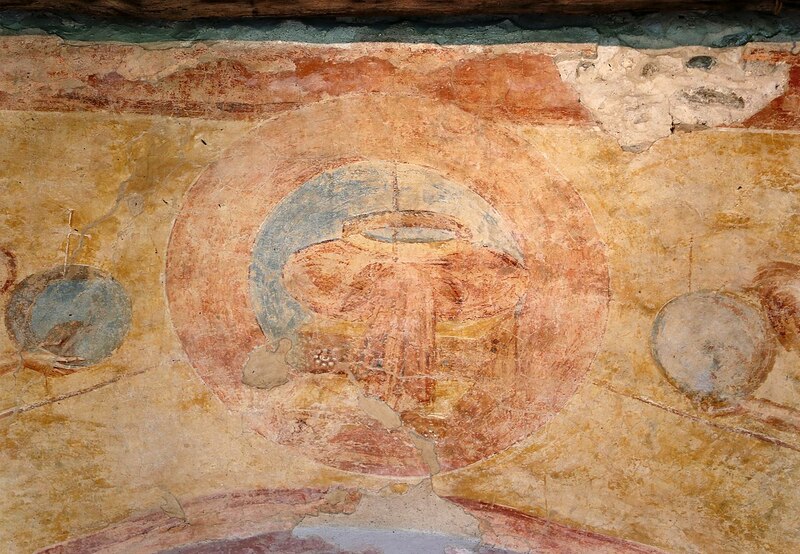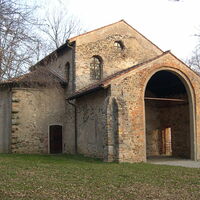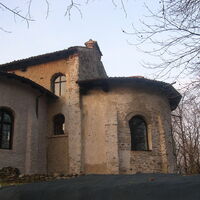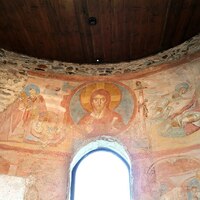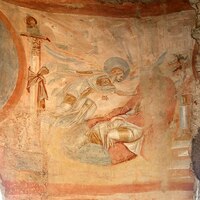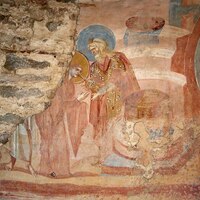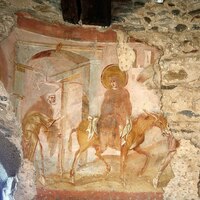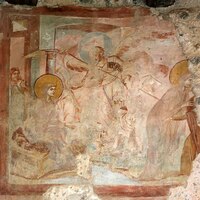Castelseprio frescoes
Type:
Churches,
Wall paintings
Date:
Mid-tenth century or ca. 700
Location or Findspot (Modern-Day Country):
Italy
Description:
A small church outside Castelseprio contains a cycle of Marian images discovered in 1944. Known as Sta. Maria foris Portas (St. Mary outside the Gates), the current triconch was originally single-apse. In addition to the Hetoimasia on the chancel arch and scenes of the Annunciation, Visitation, Journey to Bethlehem, Nativity, Adoration of the Magi, and Presentation of Jesus in the Temple, a rare fresco shows Mary undergoing a trial by drinking bitter water in the Temple. This ordeal , (based on the biblical book of Numbers 10:11–31, was meant to reveal whether a woman had been an unfaithful wife. Another scene shows a dreaming Joseph, Mary's husband, being reassured by an angel that this was not the case. There is evidence from southern Italy and from the Cairo Geniza that medieval Jews still carried out a practice to detect adulterous wives, using spring water and dust from a synagogue's Torah shrine.
Scholars have debated for decades about the date of these Byzantine-looking frescoes, in which faces are contoured not by lines but by brushstrokes of color on a greenish ground. Possible dates range from the seventh to the tenth century. The dating became clearer after carbon-14 dating of the wood beams and thermoluminescence testing of clay tiles, which together indicated that the church was built between 778 and 952. The wood was resampled in 2012 using newer methods, including dendrochronology, which yielded a date between 928 and 980. A Latin graffito scratched into the plaster preserves the name of an archbishop in Milan who held that office from 936 to 948. Carbon dating of finds in the surrounding cemetery also point to the tenth century.
In the mid-tenth century northern Italy was not part of the Byzantine realm, but the Castelseprio frescoes suggest that an itinerant Byzantine artist found work there. There were certainly ties between Byzantium and northern Italy: around 945, Bertha, the daughter of the local king, was married to the future Byzantine emperor Romanos II, an event commemorated on an extant ivory; and Byzantine aristocrats were married to the Ottonian rulers of the region beginning in 972. However, because this talented Byzantine artist left no other traces in the region, some scholars still date the Castelseprio paintings to the seventh or eighth century, when their expressive fresco style is attested in Rome. The dating debates continue.
Scholars have debated for decades about the date of these Byzantine-looking frescoes, in which faces are contoured not by lines but by brushstrokes of color on a greenish ground. Possible dates range from the seventh to the tenth century. The dating became clearer after carbon-14 dating of the wood beams and thermoluminescence testing of clay tiles, which together indicated that the church was built between 778 and 952. The wood was resampled in 2012 using newer methods, including dendrochronology, which yielded a date between 928 and 980. A Latin graffito scratched into the plaster preserves the name of an archbishop in Milan who held that office from 936 to 948. Carbon dating of finds in the surrounding cemetery also point to the tenth century.
In the mid-tenth century northern Italy was not part of the Byzantine realm, but the Castelseprio frescoes suggest that an itinerant Byzantine artist found work there. There were certainly ties between Byzantium and northern Italy: around 945, Bertha, the daughter of the local king, was married to the future Byzantine emperor Romanos II, an event commemorated on an extant ivory; and Byzantine aristocrats were married to the Ottonian rulers of the region beginning in 972. However, because this talented Byzantine artist left no other traces in the region, some scholars still date the Castelseprio paintings to the seventh or eighth century, when their expressive fresco style is attested in Rome. The dating debates continue.
Relevant Textbook Chapter(s):
4,
5
Image Credits:
Wikimedia Commons
